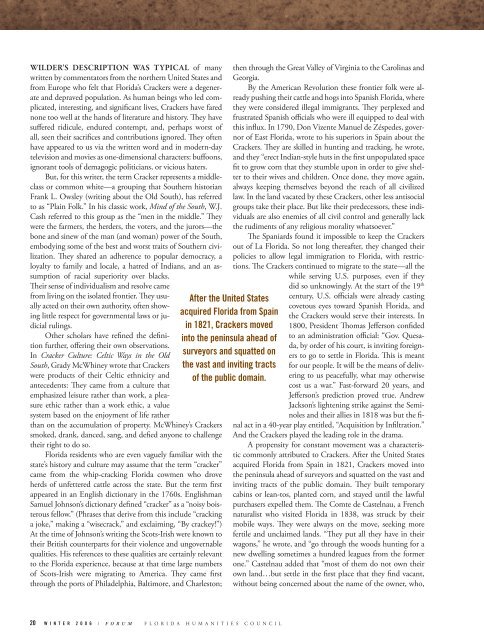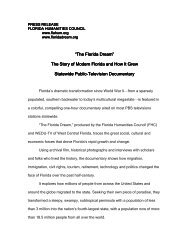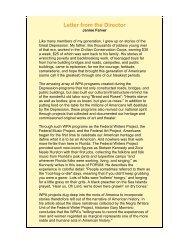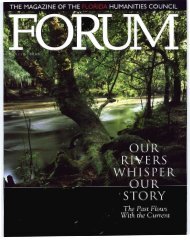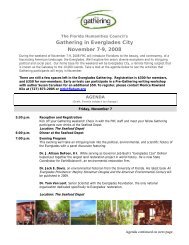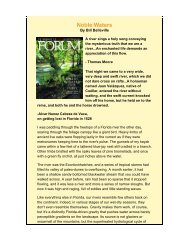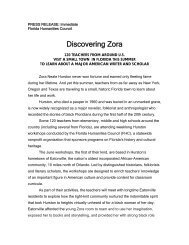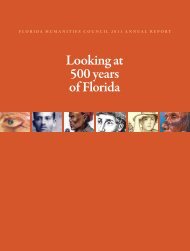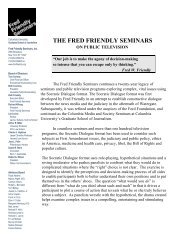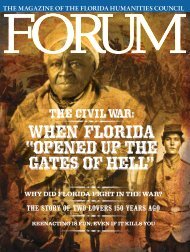THE MAGAZINE OF THE FLORIDA HUMANITIES COUNCIL
THE MAGAZINE OF THE FLORIDA HUMANITIES COUNCIL
THE MAGAZINE OF THE FLORIDA HUMANITIES COUNCIL
Create successful ePaper yourself
Turn your PDF publications into a flip-book with our unique Google optimized e-Paper software.
WilDeR’S DeScRiption WaS typical of many<br />
written by commentators from the northern United States and<br />
from Europe who felt that Florida’s Crackers were a degenerate<br />
and depraved population. As human beings who led complicated,<br />
interesting, and significant lives, Crackers have fared<br />
none too well at the hands of literature and history. They have<br />
suffered ridicule, endured contempt, and, perhaps worst of<br />
all, seen their sacrifices and contributions ignored. They often<br />
have appeared to us via the written word and in modern-day<br />
television and movies as one-dimensional characters: buffoons,<br />
ignorant tools of demagogic politicians, or vicious haters.<br />
But, for this writer, the term Cracker represents a middleclass<br />
or common white—a grouping that Southern historian<br />
Frank L. Owsley (writing about the Old South), has referred<br />
to as “Plain Folk.” In his classic work, Mind of the South, W.J.<br />
Cash referred to this group as the “men in the middle.” They<br />
were the farmers, the herders, the voters, and the jurors—the<br />
bone and sinew of the man (and woman) power of the South,<br />
embodying some of the best and worst traits of Southern civilization.<br />
They shared an adherence to popular democracy, a<br />
loyalty to family and locale, a hatred of Indians, and an assumption<br />
of racial superiority over blacks.<br />
Their sense of individualism and resolve came<br />
from living on the isolated frontier. They usually<br />
acted on their own authority, often showing<br />
little respect for governmental laws or judicial<br />
rulings.<br />
Other scholars have refined the definition<br />
further, offering their own observations.<br />
In Cracker Culture: Celtic Ways in the Old<br />
South, Grady McWhiney wrote that Crackers<br />
were products of their Celtic ethnicity and<br />
antecedents: They came from a culture that<br />
emphasized leisure rather than work, a pleasure<br />
ethic rather than a work ethic, a value<br />
system based on the enjoyment of life rather<br />
than on the accumulation of property. McWhiney’s Crackers<br />
smoked, drank, danced, sang, and defied anyone to challenge<br />
their right to do so.<br />
Florida residents who are even vaguely familiar with the<br />
state’s history and culture may assume that the term “cracker”<br />
came from the whip-cracking Florida cowmen who drove<br />
herds of unfettered cattle across the state. But the term first<br />
appeared in an English dictionary in the 1760s. Englishman<br />
Samuel Johnson’s dictionary defined “cracker” as a “noisy boisterous<br />
fellow.” (Phrases that derive from this include “cracking<br />
a joke,” making a “wisecrack,” and exclaiming, “By crackey!”)<br />
At the time of Johnson’s writing the Scots-Irish were known to<br />
their British counterparts for their violence and ungovernable<br />
qualities. His references to these qualities are certainly relevant<br />
to the Florida experience, because at that time large numbers<br />
of Scots-Irish were migrating to America. They came first<br />
through the ports of Philadelphia, Baltimore, and Charleston;<br />
After the United States<br />
acquired Florida from Spain<br />
in 1821, Crackers moved<br />
into the peninsula ahead of<br />
surveyors and squatted on<br />
the vast and inviting tracts<br />
of the public domain.<br />
20 W I N T E R 2 0 0 6 / F O R U M F L O R I D A H U M A N I T I E S C O U N C I L<br />
then through the Great Valley of Virginia to the Carolinas and<br />
Georgia.<br />
By the American Revolution these frontier folk were already<br />
pushing their cattle and hogs into Spanish Florida, where<br />
they were considered illegal immigrants. They perplexed and<br />
frustrated Spanish officials who were ill equipped to deal with<br />
this influx. In 1790, Don Vizente Manuel de Zéspedes, governor<br />
of East Florida, wrote to his superiors in Spain about the<br />
Crackers. They are skilled in hunting and tracking, he wrote,<br />
and they “erect Indian-style huts in the first unpopulated space<br />
fit to grow corn that they stumble upon in order to give shelter<br />
to their wives and children. Once done, they move again,<br />
always keeping themselves beyond the reach of all civilized<br />
law. In the land vacated by these Crackers, other less antisocial<br />
groups take their place. But like their predecessors, these individuals<br />
are also enemies of all civil control and generally lack<br />
the rudiments of any religious morality whatsoever.”<br />
The Spaniards found it impossible to keep the Crackers<br />
out of La Florida. So not long thereafter, they changed their<br />
policies to allow legal immigration to Florida, with restrictions.<br />
The Crackers continued to migrate to the state—all the<br />
while serving U.S. purposes, even if they<br />
did so unknowingly. At the start of the 19 th<br />
century, U.S. officials were already casting<br />
covetous eyes toward Spanish Florida, and<br />
the Crackers would serve their interests. In<br />
1800, President Thomas Jefferson confided<br />
to an administration official: “Gov. Quesada,<br />
by order of his court, is inviting foreigners<br />
to go to settle in Florida. This is meant<br />
for our people. It will be the means of delivering<br />
to us peacefully, what may otherwise<br />
cost us a war.” Fast-forward 20 years, and<br />
Jefferson’s prediction proved true. Andrew<br />
Jackson’s lightening strike against the Seminoles<br />
and their allies in 1818 was but the final<br />
act in a 40-year play entitled, “Acquisition by Infiltration.”<br />
And the Crackers played the leading role in the drama.<br />
A propensity for constant movement was a characteristic<br />
commonly attributed to Crackers. After the United States<br />
acquired Florida from Spain in 1821, Crackers moved into<br />
the peninsula ahead of surveyors and squatted on the vast and<br />
inviting tracts of the public domain. They built temporary<br />
cabins or lean-tos, planted corn, and stayed until the lawful<br />
purchasers expelled them. The Comte de Castelnau, a French<br />
naturalist who visited Florida in 1838, was struck by their<br />
mobile ways. They were always on the move, seeking more<br />
fertile and unclaimed lands. “They put all they have in their<br />
wagons,” he wrote, and “go through the woods hunting for a<br />
new dwelling sometimes a hundred leagues from the former<br />
one.” Castelnau added that “most of them do not own their<br />
own land…but settle in the first place that they find vacant,<br />
without being concerned about the name of the owner, who,


